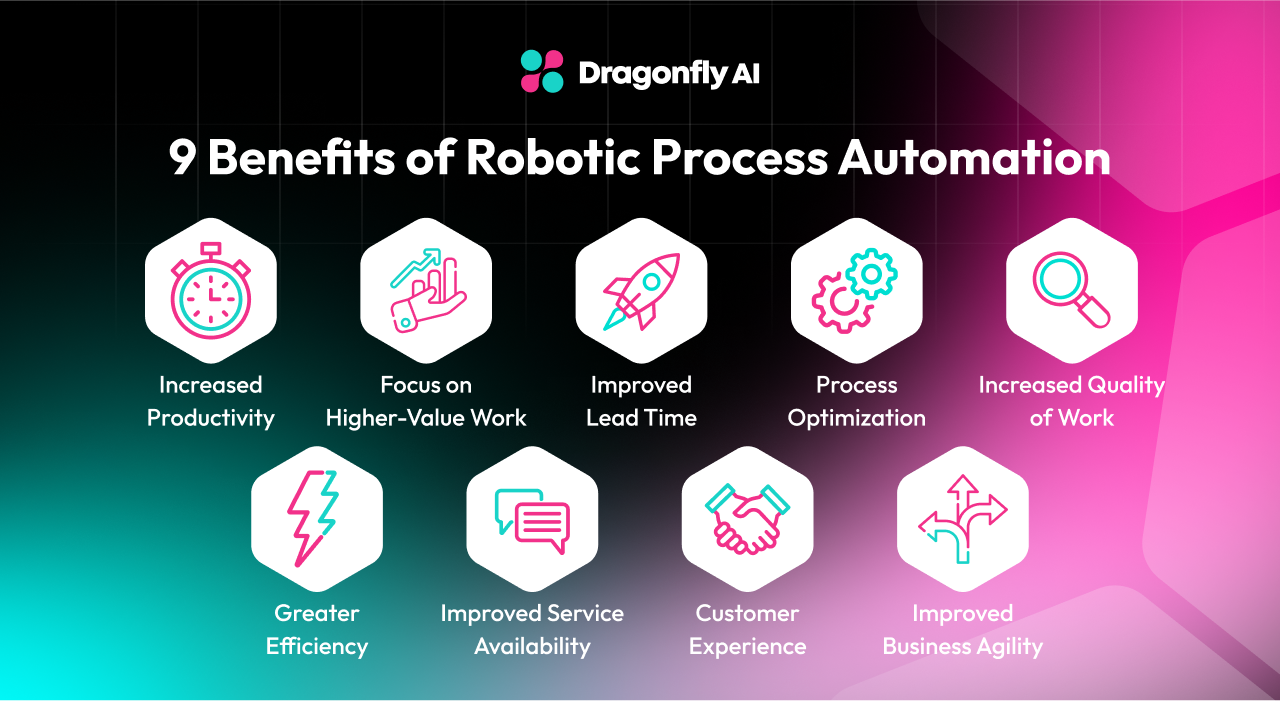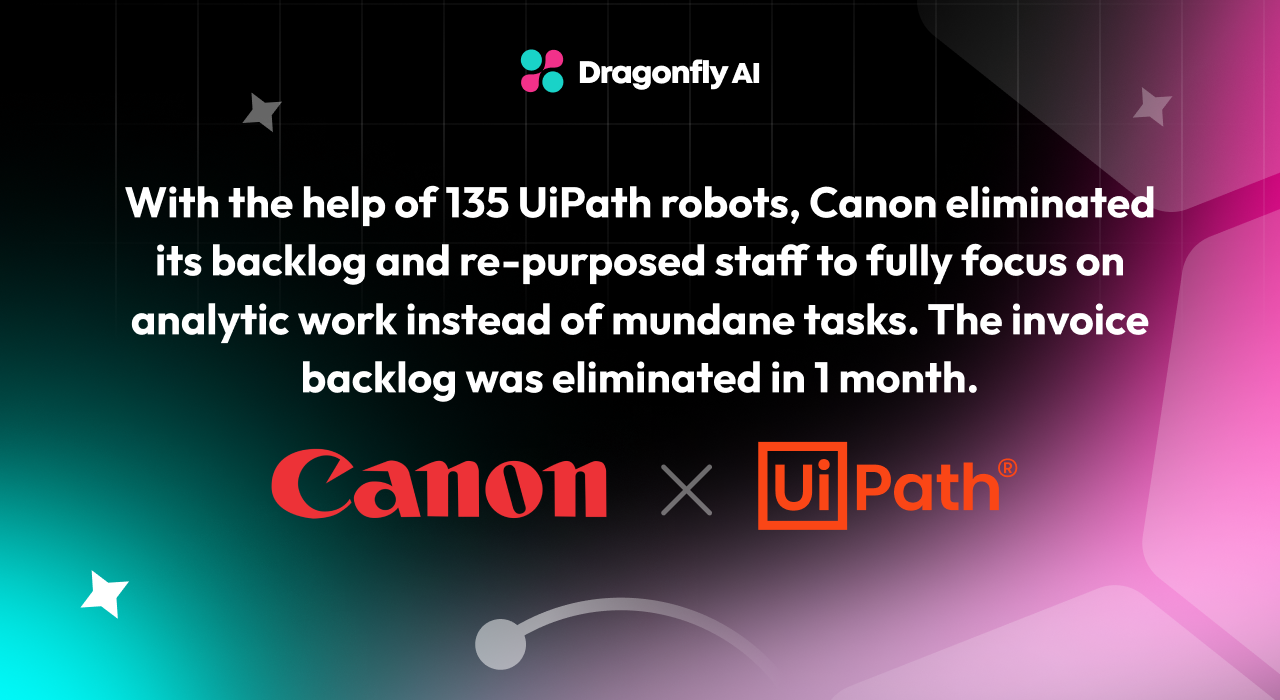Robotic Process Automation (RPA) is making a big splash in the business world, particularly in the consumer packaged goods industry and retail sectors. By automating repetitive tasks, RPA helps companies save time, cut costs, and improve accuracy.
What is Robotic Process Automation (RPA)?
RPA uses software robots, or “bots,” to handle routine (or tedious) tasks that humans usually do, like entering data into spreadsheets, processing orders, or answering simple customer service questions. These bots create automated systems that streamline repetitive tasks, minimize human error, and enhance overall efficiency.
Unlike Artificial Intelligence (AI), which learns and makes decisions based on data patterns, RPA follows predefined rules to perform tasks without making errors.
How RPA Benefits CPG and Retail
RPA offers many benefits for CPG and retail businesses by providing comprehensive automation solutions. Here are a few of the top perks of using RPA:
-
Increased Efficiency: Bots work around the clock, speeding up processes and allowing employees to focus on more strategic tasks.
-
Cost Savings: By automating repetitive tasks, companies can reduce labor costs and see a higher return on investment (ROI).
-
Improved Accuracy: RPA eliminates human errors, and completes tasks consistently and reliably.
-
Enhanced Employee Satisfaction: Employees are freed from mundane tasks and can engage in more meaningful work, boosting morale.

Transforming CPG and Retail with RPA
Robotic Process Automation is flipping the script on many aspects of the CPG industry and retail industries by taking the wheel on certain processes that otherwise tend to eat up considerable man hours.
One key area of impact is inventory management and stock replenishment. RPA provides real-time tracking of inventory levels and automates the restocking process.
RPA also helps optimize supply chain management by automating logistical tasks, such as tracking shipments and coordinating with suppliers. This automation reduces delays and improves efficiency.
Additionally, RPA strengthens order processing and fulfillment by handling the entire order cycle, from entry to shipping – speeding up the process with more accuracy and increasing customer satisfaction.
Speaking of satisfaction, customer service is something that RPA is great at. By powering chatbots and virtual assistants, RPA tools can handle common customer questions quickly and efficiently.
Comparing RPA and Intelligent Automation
When we look at Robotic Process Automation (RPA) and Intelligent Automation (IA), it's helpful to understand how each one improves CPG and retail workflows in different ways.
RPA is great for handling simple, repetitive tasks. In a retail setting, RPA can manage things like entering data, processing orders, and updating inventory records. It doesn't make decisions; it just does what it's told, quickly and accurately.
IA, on the other hand, combines RPA with artificial intelligence. This means IA can do more than just follow rules; it can analyze data and make decisions based on that information. For instance, IA can look at sales data to predict which products will be popular and when to restock them.
By using the power of both RPA and IA, you can automate routine tasks and gain valuable insights that will help you stay ahead of market changes and customer demands.
Top RPA Tools for CPG and Retail
Choosing the right RPA tool is essential when optimizing your operations in the CPG and retail industries. CPG companies face unique challenges such as the need for solutions in supply chain transparency, digital transformation, and production line flexibility. Here’s a detailed look at a few top RPA tools.
UiPath
UiPath is known for its user-friendly interface. It’s ideal for businesses looking to quickly implement RPA with minimal complexity.
UiPath's platform supports a wide range of automation tasks, from simple data entry to complex supply chain management.
UiPath offers tools like UiPath Studio for designing automation workflows and UiPath Orchestrator for managing and monitoring bots.
Most importantly, it integrates well with both user interfaces (UIs) and application programming interfaces (APIs), making it perfect for automating tasks across different systems.
UiPath also includes features for process mining and task mining, helping businesses identify the best opportunities for automation and improve process efficiency.
Blue Prism
Blue Prism is designed for large enterprises that require robust security, scalability, and compliance. It’s particularly well-suited for businesses with complex, high-volume processes that need to be automated securely and efficiently.
Blue Prism offers strong security features and seamless integration with existing IT systems. It is known for its reliability and ability to handle large-scale deployments.
Blue Prism's platform provides excellent governance and compliance capabilities, which are highly important for industries like retail where data security and regulatory compliance are critical.
The platform also supports advanced analytics and AI capabilities, to further level up the automation potential.
Automation Anywhere
Automation Anywhere is a cloud-based automation solution that’s powerful and flexible. It combines RPA with advanced analytics and AI, making it great at handling tasks that require cognitive capabilities, such as customer service automation and data analysis.
Automation Anywhere excels in cognitive automation, which uses AI to handle unstructured data and make informed decisions. It offers robust cloud-native solutions that are easy to scale and integrate with many other cloud services.
This platform is very effective for automating customer service interactions, where bots can manage inquiries and provide personalized responses based on customer data.
Automation Anywhere also features a low-code/no-code interface, making it easy for those with little technical expertise to use and enabling the creation of custom solutions tailored to specific business requirements.
When selecting an RPA tool for your CPG or retail business, consider factors like ease of integration with your existing systems, the ability to scale, and the level of security required.
Success Story: Canon’s Effective Use of RPA
Canon, a leading imaging company, struggled with a huge backlog in processing invoices, a challenge similar to those faced by many CPG manufacturers in adapting to rapidly changing market trends and consumer preferences. This manual task was slow and created a four-month delay, impacting their efficiency. To solve this problem, Canon teamed up with UiPath to use Robotic Process Automation (RPA).
They implemented over 130 UiPath robots to automate invoice processing. These bots quickly cleared the backlog in just one month. This automation not only sped up the process but also freed employees from repetitive tasks, allowing them to focus on more important work.
Using RPA transformed Canon’s operations by making their processes faster and their employees happier, showing how powerful automation can be in improving business efficiency.

Steps to Implement RPA in Your CPG or Retail Business
As you’ve probably learned by now, implementing Robotic Process Automation in your CPG or retail business can greatly improve efficiency and reduce costs.
Here’s a step-by-step guide to help get you started.
1. Identifying Processes Suitable for Automation
Begin by looking for tasks that are repetitive, time-consuming, and rule-based. These tasks are prime candidates for automation because they are predictable and can be easily handled by bots.
For example, data entry, order processing, and inventory management are all suitable processes for RPA.
2. Developing a Strategic RPA Implementation Plan with Turnkey Automation Solutions
Next, create a strategic plan for your RPA implementation. Start by defining clear goals: What do you hope to achieve with RPA? This could be reducing processing times, cutting costs, or improving accuracy.
Choose the right RPA tools that fit your business needs and allocate the necessary resources.
3. Key Considerations for Successful RPA Deployment
Verify that the RPA solution you choose has strong security features to protect sensitive data. This includes encryption, secure access controls, and regular security audits.
Training is also fundamental. Make sure your employees understand how to work with RPA bots and feel comfortable using this new technology.
4. Measuring and Analyzing the Impact of RPA
Finally, it’s important to measure the impact of RPA on your operations. Track key performance metrics such as time savings, error reduction, and cost savings. Then, analyze these metrics to see how effective your RPA implementation is and identify areas for further improvement.
Regularly reviewing and adjusting your RPA strategy will help you maximize its benefits.
The Main Challenges of RPA Adoption in the Consumer Packaged Goods Industry
Implementing RPA in your CPG or retail business can be incredibly beneficial, but it's not without its challenges.
Here’s a look at some common hurdles, how to overcome them, and the best practices for scaling RPA.
Common Challenges Faced
- Cultural Resistance: Employees might worry that automation will replace their jobs, causing fear and resistance. This can slow down the adoption of RPA and affect morale.
- Technical Issues: Integrating RPA with existing systems can be tricky. Compatibility issues and managing bot maintenance can present significant technical challenges.
- Scaling: Expanding RPA across the organization can be complex. As the number of automated processes grows, managing and coordinating these bots becomes more challenging.
Strategies for a Smooth Transition
-
Foster a Culture of Innovation: Address cultural resistance by communicating the benefits of RPA to your team. Explain how it will take over repetitive tasks, allowing them to focus on more meaningful work. Provide training and support to help employees transition to new roles. Highlight how RPA can support companies in adapting to rapid changes in the industry, enhancing operational effectiveness.
-
Technical Compatibility: Before implementing RPA, assess your current systems to ensure compatibility. Work with your IT team to identify and address potential issues.
Best Practices for Scaling RPA
- Strategic Planning: Create a clear plan that outlines your goals for RPA. Identify which processes will benefit most from automation and prioritize them. Develop a roadmap with milestones and timelines for scaling RPA.
- Strong Governance Framework: Set up a central RPA team to oversee the implementation, maintenance, and scaling of RPA. Establish clear guidelines and standards for developing and deploying bots.
- Continuous Monitoring and Optimization: Regularly monitor the performance of your RPA bots and make sure to update and optimize them as the needs of your business change.
What's Next in RPA for Digital Transformation in CPG and Retail
The future of Robotic Process Automation in this industry is promising. RPA will keep making operations more efficient by taking over repetitive tasks and letting your employees focus on more important work.
New technologies like AI and machine learning will continue to make RPA even better, as AI can handle more complex tasks by understanding and analyzing data.
As RPA continues to work with AI and other advanced technologies, it will help your business become more agile and grow faster.
By making use of RPA in your CPG and retail operations, you can simplify your processes, reduce costs, and remain competitive in this ever-evolving market.
